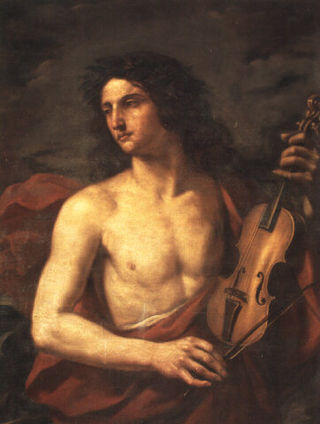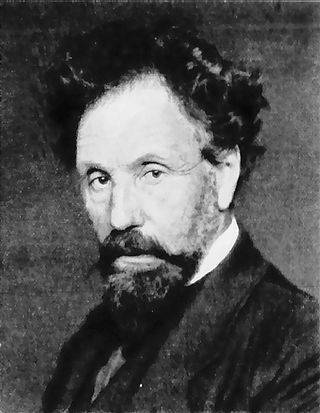
An anachronism is a chronological inconsistency in some arrangement, especially a juxtaposition of people, events, objects, language terms and customs from different time periods. The most common type of anachronism is an object misplaced in time, but it may be a verbal expression, a technology, a philosophical idea, a musical style, a material, a plant or animal, a custom, or anything else associated with a particular period that is placed outside its proper temporal domain.

Vasily Andreevich Tropinin was a Russian Romantic painter. Much of his life was spent as a serf; he didn't attain his freedom until he was more than forty years old. Three of his more important works are a portrait of Alexander Pushkin and paintings called The Lace Maker and The Gold-Embroideress.

The Indian Rebellion of 1857 was a major uprising in India in 1857–58 against the rule of the British East India Company, which functioned as a sovereign power on behalf of the British Crown. The rebellion began on 10 May 1857 in the form of a mutiny of sepoys of the Company's army in the garrison town of Meerut, 40 mi (64 km) northeast of Delhi. It then erupted into other mutinies and civilian rebellions chiefly in the upper Gangetic plain and central India, though incidents of revolt also occurred farther north and east. The rebellion posed a military threat to British power in that region, and was contained only with the rebels' defeat in Gwalior on 20 June 1858. On 1 November 1858, the British granted amnesty to all rebels not involved in murder, though they did not declare the hostilities to have formally ended until 8 July 1859.

Vasily Ivanovich Surikov was a Russian Realist history painter. Many of his works have become familiar to the general public through their use as illustrations.

Vasily Vasilyevich Vereshchagin was a Russian war artist. The graphic nature of his realist scenes led to many of them never being printed or exhibited.

Peredvizhniki, often called The Wanderers or The Itinerants in English, were a group of Russian realist artists who formed an artists' cooperative in protest of academic restrictions; it evolved into the Society for Travelling Art Exhibitions in 1870.

Hemis Monastery is a Himalayan Buddhist monastery (gompa) of the Drukpa Lineage, in Hemis 9n the bank of Indus river, Ladakh, India. Situated 45 km from Leh, it was re-established in 1672 by the Ladakhi king Sengge Namgyal. The annual Hemis festival honouring Padmasambhava is held there in early June.

Karp Ivanovich Zolotaryov was a Muscovite painter, interior designer and wood carver, employed by Posolsky prikaz and the Kremlin Armoury. Zolotaryov was the author of iconostasis of the Transfiguration church in Novodevichy Convent and the Church of the Intercession at Fili and the icons of Donskoy Monastery. Surviving paintings by Zolotaryov, created in the period directly preceding the reforms of Peter I, form a bridge between traditional Orthodox icon painting and the modern realistic painting introduced in Russia in the 18th century.
Babu Amar Singh was a revolutionary in the Indian Rebellion of 1857 and the brother of Babu Kunwar Singh, the zamindar of Jagdishpur.
Alexander Alexandrovich Naumov was a Soviet, Russian painter, lived and worked in Saint Petersburg, member of the Saint Petersburg Union of Artists, regarded as a representative of the Leningrad school of painting, the most known for his works depicting Central Asia.

William Carpenter (1818–1899) was a watercolour artist. He travelled for six or seven years in the 1850s painting scenes of India, its people and its life. The Victoria and Albert Museum bought over 280 of his paintings. In 1856 he painted Prince Fakhr-ud Din Mirza, the eldest son of Bahadur Shah II, the last King of Delhi, five months before the Prince died.

Blowing from a gun is a method of execution in which the victim is typically tied to the mouth of a cannon which is then fired, resulting in death. George Carter Stent described the process as follows:
The prisoner is generally tied to a gun with the upper part of the small of his back resting against the muzzle. When the gun is fired, his head is seen to go straight up into the air some forty or fifty feet; the arms fly off right and left, high up in the air, and fall at, perhaps, a hundred yards distance; the legs drop to the ground beneath the muzzle of the gun; and the body is literally blown away altogether, not a vestige being seen.

The Vellore mutiny,or Vellore Revolution, occurred on 10 July 1806 and was the first instance of a large-scale and violent mutiny by Indian sepoys against the East India Company, predating the Indian Rebellion of 1857 by half a century. The revolt, which took place in the Indian city of Vellore, lasted one full day, during which mutineers seized the Vellore Fort and killed or wounded 200 British troops.The mutiny was subdued by cavalry and artillery from Arcot. Total deaths amongst the mutineers were approximately 350; with summary executions of about 100 during the suppression of the outbreak, followed by the formal court-martial of smaller numbers.

Realism was an artistic movement that emerged in France in the 1840s, around the 1848 Revolution. Realists rejected Romanticism, which had dominated French literature and art since the early 19th century. Realism revolted against the exotic subject matter and the exaggerated emotionalism and drama of the Romantic movement. Instead, it sought to portray real and typical contemporary people and situations with truth and accuracy, and not avoiding unpleasant or sordid aspects of life. The movement aimed to focus on unidealized subjects and events that were previously rejected in art work. Realist works depicted people of all classes in situations that arise in ordinary life, and often reflected the changes brought by the Industrial and Commercial Revolutions. Realism was primarily concerned with how things appeared to the eye, rather than containing ideal representations of the world. The popularity of such "realistic" works grew with the introduction of photography—a new visual source that created a desire for people to produce representations which look objectively real.

Pyotr Petrovich Vereshchagin was a Russian landscape and cityscape painter in the Academic style. He was the first to paint plein-air in the wilderness of the Urals.

Nikolai Kornilievich Bodarevsky was a Ukrainian-born Russian painter and art professor; associated with the Peredvizhniki.
Ahmadullah Shah famous as the Maulvi of Faizabad, was a famous freedom fighter and leader of the Indian Rebellion of 1857. Maulavi Ahmadullah Shah was known as the lighthouse of the rebellion in the Awadh region. British officers like George Bruce Malleson and Thomas Seaton made mentions about the courage, valour, personal and organizational capabilities of Ahmadullah. G. B. Malleson mentions Ahmadullah repeatedly in the History of Indian Mutiny, a book written in 6 volumes covering Indian revolt of 1857. Thomas Seaton describes Ahmadullah Shah as:
A man of great abilities, of undaunted courage, of stern determination, and by far the best soldier among the rebels.

The Apotheosis of War is a mid 19th century painting by Russian war artist Vasily Vereshchagin. Following his completion of the painting, Vereshchagin dedicated his work "to all great conquerors, past, present and to come". Done in oil on canvas, the painting depicts a pile of skulls outside the walls of a city in Central Asia. It is considered part of Vereshchagin's Turkestan Series.
Vereshchagin's Turkestan Series is a collection of 13 paintings produced by Russian artist Vasily Vereshchagin in the 19th-century. While initially purchased en masse by a Russian collector, the works have since been added to the collections of the Tretyakov Gallery in Moscow and the Russian Museum in Saint Petersburg.

The Skull of Alum Bheg: The Life and Death of a Rebel of 1857, is a book by Kim A. Wagner, a lecturer on colonial India and the British Empire. It was published in 2017 by C. Hurst & Co., and is based on the life of Havildar Alum Bheg, a sepoy of the 46th Regiment of the Bengal Native Infantry, who following the Indian Rebellion of 1857 and being said to have killed a British missionary family in Punjab, was executed by the British by being blown from a cannon.
















